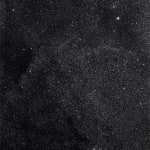

Thomas Ruff German, b. 1958
17h 16m/-45°, 1990
Chromogenic print face-mounted on Diasec, in artist's frame
258 x 186 cm; (101 5/8 x 73 1/4 in.)
Edition of 2 + 1 AP (#2/2)
A vast tableau of shimmering cosmos, 17h 16m/−45° (1990) marks Thomas Ruff’s ambitious entry into images that once belonged solely to the realm of the scientific archive. Sourced from photographic...
A vast tableau of shimmering cosmos, 17h 16m/−45° (1990) marks Thomas Ruff’s ambitious entry into images that once belonged solely to the realm of the scientific archive. Sourced from photographic negatives acquired from the European Southern Observatory in Chile, the work begins life as celestial documentation – but is transformed, through Ruff’s interventions, into something far more uncanny, far more painterly, far more abstract.
In 1998, Ruff purchased a collection of negatives from the European Southern Observatory (an international research centre in Chile) taken with a special telescopic lens as part of a comprehensive effort to document the visible universe, embarking upon his Sterne (Stars) series, to which 17h 16m/−45° belongs.
At nearly three metres high, the image dominates its space, re-oriented and enlarged from its original scientific scale; star-fields once small and remote become bold constellations, weighty with both visual noise and mystery. Ruff does not attempt to replicate what the eye “should” see; instead, he chooses what to reveal, what to emphasise, what to distort – even the notion of a horizon has no place here.
The title itself refers to celestial coordinates, and yet the title functions also as a kind of poetic distance, reminding us that this is not purely science, but an act of selection, interpretation, and imagination. What reaches us is not an objective map of the heavens, but a filtered, mediated view: stars, galaxies, light punctuated by dark spaces, all rendered with Ruff’s visual criteria rather than purely empirical measurement. Your experience of the image shifts: sometimes you read it as night sky, sometimes as abstraction, sometimes as both at once.
Ultimately, 17h 16m/−45° is less about what lies “out there” in the cosmos and more about what lies between seeing and believing. It challenges the idea of photographic truth, collapsing the boundary between documentation and abstraction. It reminds us that even in images of stars, the human impulse to make meaning – through orientation, scale, noise – presses through. It is both ancient and thoroughly contemporary, mixing the age-old wonder at the heavens with a modern mistrust of certainty.
In 1998, Ruff purchased a collection of negatives from the European Southern Observatory (an international research centre in Chile) taken with a special telescopic lens as part of a comprehensive effort to document the visible universe, embarking upon his Sterne (Stars) series, to which 17h 16m/−45° belongs.
At nearly three metres high, the image dominates its space, re-oriented and enlarged from its original scientific scale; star-fields once small and remote become bold constellations, weighty with both visual noise and mystery. Ruff does not attempt to replicate what the eye “should” see; instead, he chooses what to reveal, what to emphasise, what to distort – even the notion of a horizon has no place here.
The title itself refers to celestial coordinates, and yet the title functions also as a kind of poetic distance, reminding us that this is not purely science, but an act of selection, interpretation, and imagination. What reaches us is not an objective map of the heavens, but a filtered, mediated view: stars, galaxies, light punctuated by dark spaces, all rendered with Ruff’s visual criteria rather than purely empirical measurement. Your experience of the image shifts: sometimes you read it as night sky, sometimes as abstraction, sometimes as both at once.
Ultimately, 17h 16m/−45° is less about what lies “out there” in the cosmos and more about what lies between seeing and believing. It challenges the idea of photographic truth, collapsing the boundary between documentation and abstraction. It reminds us that even in images of stars, the human impulse to make meaning – through orientation, scale, noise – presses through. It is both ancient and thoroughly contemporary, mixing the age-old wonder at the heavens with a modern mistrust of certainty.
7
of
7

